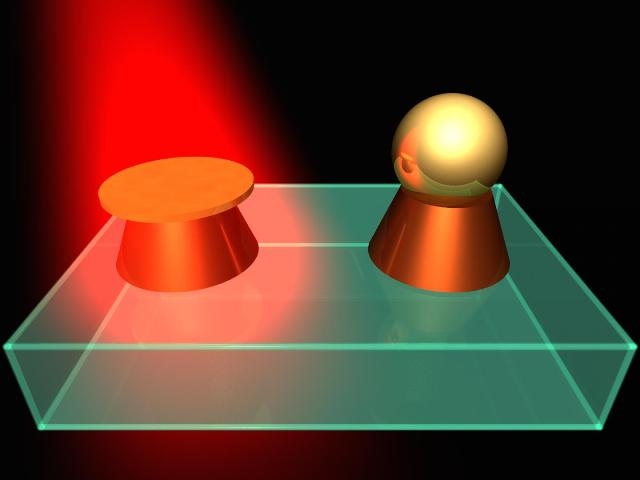 Selective laser exposure to create hybrid nanostructures. (Photo credit: ITMO University)
Selective laser exposure to create hybrid nanostructures. (Photo credit: ITMO University)
A unique approach to manipulate light at the nanoscale using hybrid metal-dielectric nanoantennas has been developed.
This novel development could be used for ultradense optical data recording and the high throughput fabrication of a broad range of optical nanodevices that can localize, improve, and manipulate light at the nanoscale.
Nanoantennas are devices that are capable of trapping freely propagating light into localized light. This nanoscale localization allows researchers to successfully control light. This unique behavior means nanoantennas are likely to become the primary building blocks of optical computers, which will use photons, rather than on electrons, to process and transmit data. Optical computers will be superior to the electronic computers that we currently use as photons have a far greater data capacity than electrons, they use less energy, there is no risk of circuit heating and, rather predictably, they travel at the speed of light.
Until now, manufacturing planar arrays of hybrid nanoantennas has been difficult and time-consuming. However, a research team at ITMO University, Saint Petersburg, have developed a method for the production of nanoantenna arrays that facilitates the modification of individual nanoantennas within the array. This method involved creating the nanoatenna array using lithography which was followed by the exposure of individual nanoantennas to an ultrashort (femtosecond) pulse laser to fine tune their properties.
The hybrid nanoantenna arrays produced are suitable for ultradense data recording. Advanced optical drives are capable of recording data at a density of 10Gbit per square inch, however, this value can be increased by modifying each nanoatenna's color using the laser method described above. This process effectively adds another 'dimension' of data recording, which expands the data storage capacity of the entire system.
Other than ultradense data recording, the selective alteration of hybrid nanoantennas will facilitate the design of hybrid metasurfaces, compact sensors and waveguides.
The nanoantennas consist of two parts: a truncated silicon cone and a thin golden disk that is situated on top. Using nanoscale laser reshaping, the researchers showed that it is possible to accurately adjust the shape of the golden particles on the top of each cone without impacting the cone itself. The modification in the shape of the golden particle promotes changes in the optical properties of the whole nanoantenna due to the varying degrees of resonance overlap between the golden nanoparticles and the silicon.
Our method opens a possibility to gradually switch the optical properties of nanoantennas by means of selective laser melting of the golden particles. Depending on the intensity of the laser beam the golden particle will either remain disc-shaped, convert into a cup or become a globe. Such precise manipulation allows us to obtain a functional hybrid nanostructure with desired properties in the flicker of a second.
Sergey Makarov, Department of Nanophotonics and Metamaterials, ITMO University
In contrast to the traditional heat-induced fabrication of nanoantennas, the novel technique increases the possibilities for modifying each nanoantenna within the array and applying accurate control over the optical properties of the hybrid nanostructures.
Our concept of asymmetric hybrid nanoantennas unifies two approaches that were previously thought to be mutually exclusive: plasmonics and all-dielectric nanophotonics. Our hybrid nanostructures inherited the advantages of both approaches - localization and enhancement of light at the nanoscale, low optical losses and the ability to control the scattering power pattern. In turn, the use of laser reshaping helps us precisely and quickly change the optical properties of such structures and perhaps even record information with extremely high density. concludes Dmitry Zuev - Department of Nanophotonics and Metamaterials, ITMO University.
The results of this research have been published in the journal Advanced Materials.